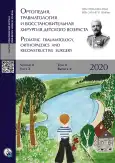一例6岁患儿肘关节前骨折脱位合并尺神经麻痹
- 作者: Ashar N.1,2,3, Liew S.1, Azmi N.2, Yeak R.1, Lingam R.2, Chen R.2
-
隶属关系:
- Universiti Putra Malaysia
- Hospital Serdang
- Universiti Teknologi MARA (UiTM), Jalan Hospital
- 期: 卷 8, 编号 2 (2020)
- 页面: 207-212
- 栏目: Clinical cases
- ##submission.dateSubmitted##: 21.11.2019
- ##submission.dateAccepted##: 04.02.2020
- ##submission.datePublished##: 01.07.2020
- URL: https://journals.eco-vector.com/turner/article/view/17721
- DOI: https://doi.org/10.17816/PTORS17721
- ID: 17721
如何引用文章
详细
背景:肘关节前骨折脱位在儿童患者中尤为罕见。在目前报道的病例中,四分之三为肘关节后脱位。肘关节前脱位的报道较少,其发生率仅不到2%。
临床病例。1例6岁女孩在厕所摔倒后左肘部发生畸形且疼痛,遂前往急诊室就诊。尺骨鹰爪表现为尺神经分布感觉减退。未见伤口,远端搏动及循环良好。X线显示左肘前脱位合并鹰嘴骨折。曾尝试闭合手法复位,但未成功。在全身麻醉下进行切开复位并经皮插入克氏针。由肘关节内侧入路。术中发现尺神经被远端尺骨碎片撞击,但仍保持连续。横向鹰嘴骨折用两根克氏针固定,复位桡骨头。尺神经可活动直至无张力。修复尺侧副韧带。肘部用夹板固定。尺骨鹰爪于第2周恢复。骨折于第6周愈合,去除克氏针。第8周,肘部可完全活动。肘部内外翻稳定。
讨论。肘关节前脱位是高能量损伤,应留意神经血管损伤。文献未对手术入路作出明确建议。我们选择肘部内侧入路进行尺神经探查和鹰嘴固定。
结论。该罕见损伤应以高度可疑指标处理。手术入路应根据肘关节的不稳定和神经血管状况单独设计,如本例为尺神经麻痹引起的后内侧不稳定。
关键词
全文:
外伤性肘关节脱位在儿童中较为少见,仅占儿童肘关节损伤的3-6%[1]。一般情
况下,即便已报道了孤立性脱位,其通常伴随并发骨折。在目前报道的病例中,四分之三为肘关节后脱位。其他较不常见的亚型包括前位、内位、外位、收敛型和分离型脱位[2]。关于小儿肘关节脱位的研究报道有限,其中大多数是罕见类型的脱位和并发症的病例报道。肘关节前脱位的报告很少,其发生率仅不到2%[3-6]。
本文报道1例6岁女孩肘关节前骨折脱位合并尺神经麻痹。
临床病例
一名健康的六岁女孩在厕所摔倒后左肘受伤。她的父母立即把她送到了急诊室。
临床可见左肘肿胀变形。无伤口或水泡。
尺骨鹰爪尺神经分布感觉减退,但存在肱动脉和远端搏动。未发现其他伤势。
左肘平片显示左肘前脱位合并鹰嘴骨折(图1)。创伤后约两小时于急诊室尝试闭合手法复位,但未成功。创伤后约6小时,在全身麻醉下进行切开复位并经皮插入克
氏针。选择肘关节内侧入路进行尺骨神经探查和骨折复位。术中发现尺神经在内侧髁沟远端被尺骨远端碎片撞击。尺神经被拉长,略显苍白,但仍保持连续。尺神经近端和远端可活动至无张力。鹰嘴干骺端骨折,骺端
附着骨膜带,其属Salter-Harris II型
骨折。采用温和控制牵引进行肘部骨复位。采用两根平行克氏针固定骨折,自行复位桡骨头。内侧副韧带(MCL)完全撕裂,用5/0可吸收缝线修复。在术中对患者的肘关节在旋后、旋前、屈位和伸位的稳定性进行了
评估。复位修复后肱动脉、桡动脉和尺动脉搏动良好。肘部以90度屈曲固定,前臂在夹板上旋后弯曲(图2)。
图 1。左肘平片显示肘关节前脱位合并鹰嘴骨折
图 2。左肘术后平片。减少脱位,用克氏针固定鹰嘴骨折
术后1周,小指和无名指麻木临床有所
改善。尺骨鹰爪在2周时恢复。6周时骨折
愈合,去除克氏针(图3)。第4周开始肘部轻微被动运动,第6周开始主动运动。
6周时去除夹板。在第8周,肘部可充分
活动。肘部在内翻和外翻应力测试中呈
稳定。患者能恢复正常活动。目前其处于每3个月接受随访(图4)。
图 3。术后6周骨折愈合
图 4。患者左肘在术后8周的活动范围:a — 弯曲;b — 伸展;c — 旋后;d — 旋前
讨论
肘关节脱位在儿童中并不常见。儿童肘关节脱位的发病率高峰在10至15岁骺板开始闭合时[7]。由于对尺肱骨关节和后柱软组织结构(即肱三头肌和后囊)有较强的稳定作用,肘关节前脱位比较少见[8]。
前脱位可直接作用于前臂背侧,肘关节处于半屈曲位置,并伴有肱三头肌插入点附近的鹰嘴尖撕脱[1, 9, 10]。此现象在该病例中的术中探查时可见。
据报告,75%的儿童肘关节脱位伴有肘关节损伤,24%的病例在初次X光片中未得到诊断[7]。常见的相关损伤有上髁内侧撕脱伤、鹰嘴撕脱伤、冠状突骨折、内外侧髁骨折、桡骨头颈骨折。在这些病例中,平片的漏诊可延误正确处理。骨软骨碎片或遗漏的撕脱可导致关节复位不当和复发性脱位。因此,磁共振成像(MRI)可帮助可疑或难复性病例的诊断。
在肘关节脱位合并内上髁骨折时,正中
神经损伤的风险最大,其次是尺神经
损伤[5]。前脱位中尺神经损伤少见。
本例由于闭合复位不成功,且尺神经有压迫
迹象,因此值得进行开放复位和尺神经
探查。文献未明确建议手术入路和技术。
我们选择肘关节内侧入路以减少脱位,同时探查尺神经。Linscheid和Wheeler[3]建议在切开复位时行尺神经转位,但我们发现这是不必要的,因为该神经未受到严重损伤,且在原位保持无张力。
鲜有报道探讨小儿肘关节脱位中韧带不稳定的情况。本例前脱位的方向为前
内侧,MCL完全撕裂,采用直接修复恢复内侧稳定性。对于关节复位后的固定时间没有共识,应平衡处理关节的稳定性和肘关节僵直问题。
肘关节脱位会引起血管损伤已得到
公认,尤其是开放性损伤[11, 12]。仔细的远端循环检查至关重要,因为血管壁的内膜损伤或血栓形成可能较晚才出现。
结论
肘关节前脱位合并尺神经麻痹在儿童中是非常罕见的。肘部的相关损伤不容遗漏。早期诊断、及时治疗、合理安排手术可获得良好的预后,预防并发症的发生。
其它信息
资金来源。无资金来源。
利益冲突。作者声明,该篇文章的出版无明确和潜在的利益冲突。
伦理审查。患者及其父母已同意发表本病例报告。
作者贡献
N.A.K. Ashar — 负责提出研究概念,
撰写文章并收集资料。
S.K. Liew — 负责提出研究概念,撰写
文章,对重要的知识内容进行关键修改。
负责文章的所有方面,并确保研究的准确性和完整性。
N.S. Azmi、R. Lingam、R.A. Chen —
对构思和文章起草、数据收集和分析做出实质性贡献。
R.D.K. Yeak — 对重要的知识内容和分析进行关键修改。
所有作者都对文章的研究和准备做出了重大贡献,在发表前阅读并批准了最
终版本。
作者简介
Nur Ayuni Khirul Ashar
Universiti Putra Malaysia; Hospital Serdang; Universiti Teknologi MARA (UiTM), Jalan Hospital
Email: ayuni.kashar@gmail.com
ORCID iD: 0000-0003-3556-0721
D-r, MBBS (UiTM), Postgraduate student & Medical Officer of the Department of Orthopaedic, Faculty of Medicine and Health Sciences
马来西亚, Serdang, Selangor; Jalan Puchong, Kajang, Selangor; Sungai Buloh, SelangorSiew Khei Liew
Universiti Putra Malaysia
编辑信件的主要联系方式.
Email: kheils@upm.edu.my
ORCID iD: 0000-0003-4419-1382
D-r, MBBS (UM), MS ORTH (UM), Orthopaedic Surgeon, Hand and Reconstructive Microsurgery Unit of the Department of Orthopaedic, Faculty of Medicine and Health Sciences
马来西亚, Serdang, SelangorNur Syahirah Azmi
Hospital Serdang
Email: syahirahazmi90@gmail.com
ORCID iD: 0000-0002-4057-3749
D-r, MB BCh (Mansoura University), Medical Officer of the Department of Orthopaedic
马来西亚, Jalan Puchong, Kajang, SelangorRaymond Dieu Kiat Yeak
Universiti Putra Malaysia
Email: rayyeak@yahoo.com
ORCID iD: 0000-0001-8232-5359
D-r, MB BCh BAO (PMC), MS ORTH (UM), Orthopaedic Surgeon, Sports Surgery Unit of the Department of Orthopaedic, Faculty of Medicine and Health Sciences
马来西亚, Serdang, SelangorRahul Lingam
Hospital Serdang
Email: silverseraph15@yahoo.com
ORCID iD: 0000-0002-0546-3077
D-r, MD (KSMU), Doctor of Medicine, Medical Officer of the Department of Orthopaedic
马来西亚, Jalan Puchong, Kajang, SelangorRaimi Adam Chen
Hospital Serdang
Email: hadoken86@gmail.com
Scopus 作者 ID: 0000-0003-0362-521X
D-r, MD (RSMU), Doctor of Medicine, Medical Officer of the Department of Orthopaedic
马来西亚, Jalan Puchong, Kajang, Selangor参考
- Wilkins KE. Fractures and dislocations of the elbow region. In: Fractures in children. 4th ed. Vol. 3. Ed. by C.A. Rockwood, K.E. Wilkins, R.E. King. Philadelphia: Lippincott-Raven; 1996. P. 653-887.
- Dharmshaktu G, Singhal A, Khan I. Elbow dislocation in a 3 year old child: a report of a rare injury. Int J Contemp Pediatrics. 2015:254-256. https://doi.org/10.18203/2349-3291.ijcp20150539.
- Linscheid RL. Elbow Dislocations. JAMA. 1965;194(11):1171. https://doi.org/10.1001/jama.1965. 03090240005001.
- Josefsson PO, Nilsson BE. Incidence of elbow dislocation. Acta Orthop Scand. 2009;57(6):537-538. https://doi.org/10.3109/17453678609014788.
- Neviaser JS, Wickstrom JK. Dislocation of the elbow: a retrospective study of 115 patients. South Med J. 1977;70(2):172-173. https://doi.org/10.1097/00007611-197702000-00013.
- Roberts PH. Dislocation of the elbow. Br J Surg. 1969;56(11):806-815. https://doi.org/10.1002/bjs. 1800561103.
- Kaziz H, Naouar N, Osman W, Ayeche M. Outcomes of paediatric elbow dislocations. Malays Orthop J. 2016;10(1):44-49. https://doi.org/10.5704/MOJ.1603.008.
- Pokharel B, Gyawali GP, Pokharel R. Irreducible anterior dislocation of the elbow without associated fracture. J Nepal Med Assoc. 2013;52(190). https://doi.org/10.31729/jnma.2120.
- Aroojis A, Narula V, Sanghvi D. Pure medial elbow dislocation without concomitant fracture in a 10-year-old child. Indian J Orthop. 2018;52(6):678-681. https://doi.org/10.4103/ortho.IJOrtho_534_17.
- Kumar R, Sekhawat V, Sankhala SS, Bijarnia I. Anterior dislocation of elbow joint-case report of a rare injury. J Orthop Case Rep. 2014;4(3):16-18. https://doi.org/10.13107/jocr.2250-0685.186.
- Kailash S, Shanmuganathan S. Anterior dislocation of elbow with neurovascular injury: a rare case report. J Orthop Case Rep. 2017;7(1):91-94. https://doi.org/10.13107/jocr.2250-0685.704.
- Hyvonen H, Korhonen L, Hannonen J, et al. Recent trends in children’s elbow dislocation with or without a concomitant fracture. BMC Musculoskelet Disord. 2019;20(1):294. https://doi.org/10.1186/s12891-019-2651-8.
补充文件











